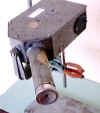
 SM046
Photometer circa
1960 Light
SM046
Photometer circa
1960 Light
The measurement of the intensity of illumination and luminous intensity
is achieved by comparison with a standard source using a photometer.
The flicker photometer (SM207) consists of a rotating white target that
is alternately illuminated by each of the sources.
As the intensity produced by the source to be measured at the
photometer approaches that of the standard source the flicker which can
be seen through the eyepiece begins to diminish until a point is reached
where no flicker is apparent.
At this point the intensities of the sources are proportional to
the inverse of the square of their distance from the photometer.
An advantage of
the flicker photometer over the other types is that it is unaffected by
a variation in the colour temperature between the sources as a position
of minimum flicker can always be attained.
Another type of photometer is the Lummer-Brodhun, or Swan photometer
(SM046), which uses two right-angled prisms with the hypotenuse faces in
optical contact over a small circular area.
The two sources to be compared illuminate two opposite sides of a
screen and the light from each face passes to the appropriate prism,
illuminating the circular area and the surrounding area correspondingly.
The intensity of the circular area is compared with the
surrounding area as seen through a magnifying eyepiece.
As in the previous instrument, the distances from the sources are
measured, but in this case a difference in colour temperature will cause
a difficulty in finding the correct match.
The two types of photometers mentioned were developed as an improvement
on Bunsenís grease-spot photometer where a translucent grease mark on
paper is used to compare the transmitted and reflected light from the
two sources coming from opposite sides.
Intensity of illumination can also be measured directly by means of a
photoelectric cell, usually of Copper oxide, driving a sensitive
galvanometer with a load resistor.
The meter scale is calibrated in the appropriate units such as
foot-candles or Lux.
The photoelectric instrument such as SM237 may have low and high
light scales to cover a large measurement range.

![]()
 Museum
Museum
![]()
 SM046
Photometer circa
1960 Light
SM046
Photometer circa
1960 Light![]()